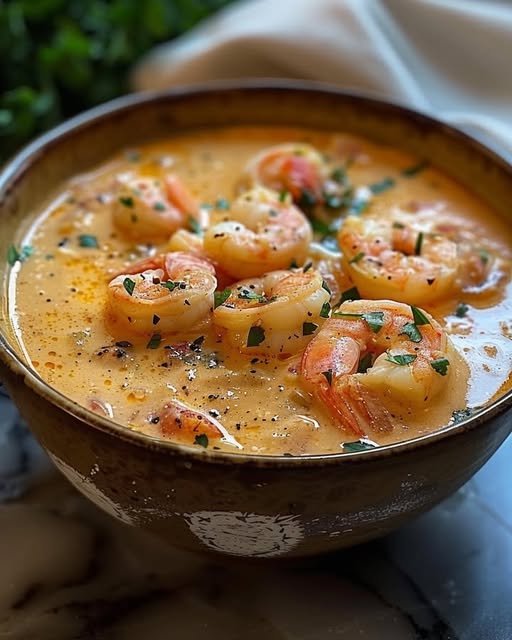Creamy Crab and Shrimp Bisque: A Luxurious Seafood Soup You Can Make at Home
This creamy crab and shrimp bisque delivers restaurant-quality flavors with surprisingly simple techniques. The rich, velvety broth combines sweet seafood with aromatic herbs and a touch of sherry for depth. Meanwhile, tender chunks of crab and shrimp create satisfying texture contrasts in every spoonful.
Perfect for special occasions or when you crave something indulgent, this easy homemade recipe transforms basic ingredients into an elegant dish. The bisque develops complex flavors through careful layering of ingredients, yet remains approachable for home cooks. Furthermore, you can customize the spice level and thickness to suit your preferences.
Quick Recipe Highlights
- Flavor Profile: The bisque balances sweet crab and shrimp with savory aromatics, bright sherry notes, and subtle heat from cayenne pepper. Additionally, fresh herbs add brightness to the rich base.
- Texture: Silky smooth broth contrasts with tender seafood pieces, while optional garnishes like croutons provide crunch. Moreover, the cream creates luxurious mouthfeel without overwhelming the delicate flavors.
- Aroma: Fragrant onions, garlic, and celery form the base, while sherry and seafood stock create depth. Finally, fresh parsley and thyme add herbal complexity.
- Visual Appeal: The pale orange bisque showcases pink shrimp and white crab meat beautifully. Consequently, colorful garnishes like paprika or chives make it Instagram-worthy.
- Skill Level Needed: Basic knife skills and patience with simmering produce excellent results. However, the recipe includes tips to simplify each step.
- Special Equipment: A blender or immersion blender ensures smooth texture, though you can strain for similar results. Meanwhile, a heavy-bottomed pot prevents scorching.
Recipe Overview
- Difficulty Level: While not complicated, this recipe requires attention to timing and technique. Specifically, proper seafood cooking and careful blending create the best texture. Nevertheless, beginners can succeed by following instructions closely.
- Category: This bisque works as an impressive starter or light main course. Alternatively, pair it with crusty bread for casual dining.
- Cuisine: Rooted in French culinary tradition, the recipe incorporates American coastal ingredients. Similarly, the sherry addition nods to Spanish influences.
- Cost: Using frozen seafood reduces expense without sacrificing quality. Comparatively, fresh crab and shrimp elevate the dish for special occasions.
- Season: Ideal year-round, but particularly comforting in cooler months. Conversely, lighter summer versions work with seasonal produce.
- Occasion: Equally suited for date nights, holiday meals, or treating yourself. Subsequently, the elegant presentation impresses guests effortlessly.
Why You’ll Love This Creamy Crab and Shrimp Bisque
First, the luxurious texture makes this bisque feel special without excessive effort. The combination of pureed aromatics and cream creates velvety smoothness that coats each piece of seafood. Meanwhile, the recipe allows for customization based on your preferred thickness.
Second, the flavor development comes from layering ingredients thoughtfully. Starting with a classic mirepoix builds depth, while deglazing with sherry adds complexity. Furthermore, quality seafood stock amplifies the natural sweetness of crab and shrimp.
Third, the recipe offers flexibility for different skill levels. Beginners can follow the straightforward steps, while experienced cooks might experiment with garnishes or spice adjustments. Additionally, the make-ahead potential simplifies entertaining.
Fourth, the nutritional profile provides lean protein and beneficial omega-3s. Although rich, the bisque balances indulgence with wholesome ingredients. Similarly, portion control comes naturally with the satisfying richness.
Finally, the cost compares favorably to restaurant versions. By preparing this at home, you enjoy premium flavors without premium prices. Moreover, leftovers taste even better as flavors meld overnight.
Historical Background and Cultural Significance
Bisques originated in 17th century France as a way to utilize shellfish shells. Traditionally, cooks pounded crustacean shells to extract maximum flavor before straining. Over time, the technique evolved to include cream and refined preparation methods.
In coastal America, bisques became popular as seafood processing developed. Specifically, Chesapeake Bay and Gulf Coast regions adapted French techniques to local crab and shrimp. Consequently, regional variations emerged based on available ingredients.
The addition of sherry reflects Spanish culinary influence in European cooking. Originally, fortified wines helped preserve seafood dishes before refrigeration. Nowadays, the alcohol cooks off while leaving complex flavor notes.
Modern interpretations balance tradition with convenience. While purists might use whole live crabs, contemporary recipes often incorporate pre-shelled meat. Nevertheless, the essential characteristics of smooth texture and seafood essence remain unchanged.
Ingredient Deep Dive
Crab meat forms the soul of this bisque, contributing sweet brininess. Look for fresh lump crabmeat or high-quality pasteurized cans. Importantly, drain excess liquid to prevent watering down the bisque. For best results, gently fold in crab at the end to maintain texture.
Shrimp add complementary flavor and visual appeal. Medium-sized shrimp (41-50 count) work well for balanced bites. Notably, reserving some whole shrimp for garnish enhances presentation. Alternatively, use smaller shrimp throughout for consistent texture.
Seafood stock amplifies the oceanic essence without overpowering. Quality store-bought versions save time, while homemade provides superior depth. In either case, reduce the stock slightly to concentrate flavors before adding cream.
Heavy cream creates the signature velvety texture. For lighter versions, substitute half-and-half or whole milk. However, the bisque will be slightly less rich. Importantly, temper cream with hot liquid to prevent curdling.
Common Mistakes to Avoid
- Overcooking seafood: Shrimp turn rubbery and crab loses sweetness when cooked too long. Instead, add them at the final stage just to heat through.
- Rushing the roux: Taking time to cook flour properly prevents raw taste. Specifically, aim for pale golden color before adding liquids.
- Over-blending: Pureeing cooked seafood creates unpleasant texture. Therefore, blend only the aromatics and broth before adding whole pieces.
- Insufficient seasoning: Seafood dishes require bold seasoning to shine. Accordingly, taste and adjust salt carefully throughout cooking.
- Using low-quality sherry: The flavor concentrates, so choose drinking-quality sherry. Conversely, cooking sherry contains salt and additives.
- Skipping the garnish: Fresh herbs and a sprinkle of paprika transform appearance. Similarly, a drizzle of cream adds professional polish.
- Overcrowding the pot: Cook shrimp in batches if necessary. Otherwise, they steam instead of sear properly.
- Neglecting to deglaze: Scrape up flavorful browned bits when adding sherry. Otherwise, you lose depth of flavor.
Essential Techniques
Making a proper roux forms the foundation for creamy texture. Equal parts butter and flour cook together to thicken the bisque. Importantly, stir constantly to prevent burning and achieve smooth consistency. The mixture should smell nutty but not brown for this application.
Deglazing with sherry lifts flavorful fond from the pan bottom. After sautéing vegetables, the alcohol helps dissolve caramelized bits. Subsequently, simmer until the sharp alcohol aroma dissipates, leaving only rich flavor.
Blending creates the signature smooth bisque texture. An immersion blender works directly in the pot, while countertop models require careful transferring. In both cases, cover the opening with a towel to prevent splatters.
Finishing with cream requires tempering to prevent curdling. First, whisk some hot liquid into the cream to warm it gradually. Then incorporate the mixture back into the pot while stirring constantly.
Pro Tips for Perfect Creamy Crab and Shrimp Bisque
- Reserve some whole shrimp for garnish, creating visual appeal and texture contrast.
- Use seafood shells to make quick stock by simmering with aromatics while prepping other ingredients.
- Chill bowls briefly before serving to keep the bisque hot longer at the table.
- Add a pinch of cayenne pepper to enhance other flavors without noticeable heat.
- Swirl in a teaspoon of cold butter at the end for extra shine and richness.
- Freeze leftover bisque without cream, then add fresh cream when reheating.
- Toast bread cubes in seafood-infused oil for gourmet croutons.
Variations and Adaptations
For regional twists, incorporate local seafood specialties. New England versions might add lobster, while Southern adaptations could include okra. Alternatively, Mediterranean influences work well with saffron and fennel.
Seasonal variations keep the recipe fresh year-round. Spring versions highlight fresh peas and tender herbs. Conversely, fall adaptations might include roasted squash or mushrooms for earthiness.
Dietary modifications accommodate various needs. Gluten-free versions use rice flour or cornstarch for thickening. Similarly, dairy-free cooks can substitute coconut cream with excellent results.
Flavor variations allow personalization. Smoked paprika adds depth, while lemon zest brightens the richness. Additionally, a splash of brandy or cognac creates sophisticated complexity.
Serving and Presentation Guide
Traditional bisque service emphasizes elegance. Warm wide-rimmed bowls showcase the creamy texture and garnishes. Subsequently, place bowls on charger plates for formal occasions.
Garnishing elevates both appearance and flavor. A drizzle of herb oil or swirl of crème fraîche adds visual interest. Likewise, strategically placed whole shrimp and crab claws signal quality ingredients.
Accompaniments should complement without overwhelming. Lightly toasted baguette slices or delicate crackers provide textural contrast. Alternatively, serve with a simple green salad for balance.
Temperature control ensures optimal enjoyment. Keep serving bowls warm to maintain heat, but avoid overheating that could curdle the cream. Similarly, warn guests about hot bowls if using oven-warmed dishes.
Wine and Beverage Pairing
White wines with acidity cut through the bisque’s richness. Chardonnay with balanced oak works beautifully, as does crisp Sauvignon Blanc. Additionally, dry Riesling complements the seafood sweetness.
For non-alcoholic options, consider sparkling water with citrus. The effervescence cleanses the palate between bites. Alternatively, jasmine tea provides floral notes that enhance the bisque.
Sherry makes a natural pairing, echoing the recipe ingredient. Choose a dry fino or amontillado style to avoid sweetness overload. Moreover, serve slightly chilled to refresh the palate.
Craft cocktails can mirror the bisque’s flavors. A gin-based drink with herbal notes complements the thyme and parsley. Similarly, a Bloody Mary riff with seafood garnish creates thematic harmony.
Storage and Shelf Life
Proper storage maintains quality and safety. Cool the bisque completely before refrigerating in airtight containers. Importantly, consume within 2 days for best texture and flavor.
Freezing works well for longer storage. However, omit the cream before freezing, then add fresh when reheating. Subsequently, frozen bisque keeps for up to 2 months with minimal quality loss.
Reheating requires gentle heat to prevent separation. Warm slowly over low heat while stirring frequently. Moreover, add a splash of stock or cream if the bisque thickens too much.
Signs of spoilage include sour smell or texture changes. Discard any bisque with off odors or visible mold. Additionally, seafood dishes spoil faster than other leftovers, so err on the side of caution.
Make Ahead Strategies
Advance preparation streamlines cooking when entertaining. The base can be made 1-2 days ahead, stopping before adding seafood and cream. Consequently, final assembly takes just 15 minutes before serving.
Proper cooling prevents bacterial growth. Spread the base in a shallow container to chill quickly. Then cover tightly once at room temperature before refrigerating.
Reheating the base requires care. Warm gently while stirring to prevent sticking. Meanwhile, prepare fresh garnishes and seafood for last-minute addition.
Timing adjustments help coordinate meal service. Cook shrimp and crab just before serving for perfect texture. Similarly, add cream at the end to maintain fresh flavor.
Scaling Instructions
Doubling the recipe works well for crowds. Use a wider pot to allow proper evaporation. Furthermore, extend cooking time slightly to develop flavors fully.
Halving the recipe suits smaller households. Reduce pan size to maintain proper depth for simmering. Additionally, watch carefully as smaller quantities cook faster.
Equipment adjustments ensure consistent results. Larger batches may require blending in stages. Conversely, small batches need careful monitoring to prevent over-reduction.
Timing modifications account for quantity changes. More volume requires longer heating throughout. Nevertheless, seafood cooking times remain constant regardless of batch size.
Nutritional Deep Dive
The bisque provides high-quality protein from seafood. Crab and shrimp offer lean protein with minimal saturated fat. Additionally, they contain beneficial omega-3 fatty acids.
Vitamin and mineral content varies by ingredients. Seafood provides B vitamins and minerals like zinc and selenium. Meanwhile, vegetables contribute fiber and micronutrients.
Calorie control comes through portion management. The rich flavor satisfies quickly, making smaller portions fulfilling. Moreover, balancing with lighter sides creates complete meals.
Dietary considerations include shellfish allergies as primary concern. For lactose intolerance, dairy alternatives work well. Similarly, gluten-free adaptations are straightforward.
Dietary Adaptations
Gluten-free versions substitute the roux with alternatives. Rice flour or cornstarch thicken effectively without gluten. Additionally, ensure all other ingredients meet gluten-free standards.
Dairy-free adaptations use coconut cream or cashew cream. These substitutes provide richness while accommodating restrictions. Furthermore, they complement the seafood flavors surprisingly well.
Low-carb modifications reduce thickeners significantly. The natural seafood flavors shine with minimal starch. Alternatively, xanthan gum provides thickening without carbs.
Paleo versions focus on whole food ingredients. Homemade seafood stock and ghee replace conventional options. Similarly, omit sherry or use compliant alcohol alternatives.
Troubleshooting Guide
If the bisque seems too thin, simmer longer to reduce. Alternatively, make a quick slurry with cornstarch and cold water. Then whisk in gradually until desired consistency.
For overly thick bisque, stir in additional stock or water. Heat gently while incorporating the liquid. Moreover, adjust seasoning after dilution.
Curdled appearance indicates overheating after adding cream. Strain through a fine mesh sieve to salvage. Then blend briefly to restore smoothness.
Lackluster flavor may need acid balance. A squeeze of lemon juice often brightens dull flavors. Additionally, check salt levels and adjust carefully.
Recipe Success Stories
Home cooks praise the recipe’s restaurant-quality results. Many report receiving compliments from guests unaware of the simple preparation. Furthermore, several have adapted it successfully for various dietary needs.
Creative variations demonstrate the recipe’s versatility. Some add corn for sweetness, while others incorporate spicy peppers. Consequently, each cook can personalize while maintaining the essential character.
Entertaining successes highlight the make-ahead advantages. Hosts appreciate finishing touches taking minimal time during parties. Similarly, the elegant presentation impresses without last-minute stress.
Family adaptations make the recipe accessible to all ages. Mild versions please children, while adults enjoy sherry accents. Moreover, the rich flavor appeals across generations.
Frequently Asked Questions
Can I use frozen seafood? Yes, thaw completely and pat dry before using. Quality frozen seafood works well, especially when fresh isn’t available.
What’s the best sherry substitute? Dry white wine or vermouth work, though flavor will differ slightly. For non-alcoholic versions, use seafood stock with a touch of vinegar.
How do I prevent the cream from curdling? Temper it with hot liquid first and avoid boiling after addition. Also, use heavy cream which resists curdling better than lighter options.
Can I make this vegetarian? While not traditional, mushroom broth with seaweed mimics some seafood notes. Add vegetables like corn and potatoes for substance.
Why does my bisque taste bland? Underseasoning is common with rich dishes. Adjust salt carefully and consider a splash of lemon juice to brighten flavors.
How can I thicken without flour? Pureed vegetables or a cornstarch slurry work well. Alternatively, reduce the bisque longer for natural thickness.
What’s the best crab to use? Lump crabmeat offers nice texture and flavor. Claw meat works too for more economical versions.
Can I freeze leftovers? Yes, but best without cream. Add fresh cream when reheating frozen base for best texture.
How do I fix a grainy texture? Strain through a fine mesh sieve and blend again if needed. Overcooked seafood often causes this issue.
What sides pair well? Light salads, crusty bread, or simple roasted vegetables complement without overwhelming.
Additional Resources
For seafood preparation techniques, consult reliable cooking guides. Proper cleaning and deveining ensure best results. Additionally, learn to identify fresh seafood quality markers.
Stock-making tutorials elevate homemade versions. Simple shellfish stock uses shells and basic aromatics. Furthermore, pressure cooker methods save significant time.
Wine pairing guides help select perfect accompaniments. Regional matches often work beautifully. Similarly, consider the occasion when choosing beverages.
Presentation resources inspire creative serving ideas. Garnishing techniques transform simple dishes. Moreover, proper table setting enhances the dining experience.
PrintCreamy Crab and Shrimp Bisque – Easy Homemade Recipe
Description
A rich and velvety bisque loaded with succulent crab and shrimp, perfect for a cozy dinner.
Ingredients
For the Crust:
- 1 lb crab meat
- 1 lb shrimp, peeled and deveined
- 4 cups seafood stock
- 1 cup heavy cream
- 1/2 cup unsalted butter
- 1/2 cup all-purpose flour
- 1 onion, finely chopped
- 2 cloves garlic, minced
- 1 tsp paprika
- 1 tsp Old Bay seasoning
- Salt and pepper to taste
- 2 tbsp fresh parsley, chopped
Instructions
1. Prepare the Crust:
- In a large pot, melt butter over medium heat. Add onion and garlic, sauté until translucent.
- Whisk in flour to create a roux, cooking for 2 minutes until golden.
- Gradually pour in seafood stock, whisking continuously to avoid lumps.
- Add crab meat, shrimp, paprika, Old Bay seasoning, salt, and pepper. Simmer for 15 minutes.
- Stir in heavy cream and simmer for an additional 5 minutes.
- Garnish with fresh parsley before serving.
Notes
You can customize the seasonings to taste.





